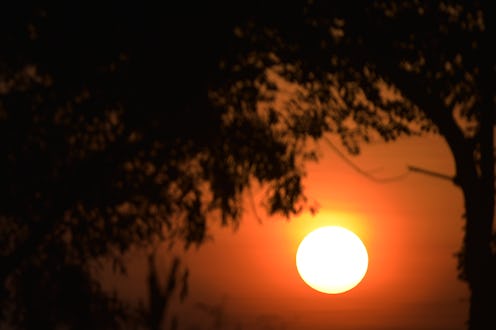
If you, like many Americans, are prepping to join your fellow sun stans on Solar Eclipse Twitter on Monday, you're going to need to be adequately prepped on what to expect. Perhaps the most pressing question on everyone's mind: Exactly how long will it be dark during the solar eclipse? Should we be expecting a quick little blip, or full on apocalypse vibes?
The length of the eclipse and just how apparent the darkness will be depends on where you're watching the eclipse from. The total solar eclipse on Aug. 21 will be the first that the United States will be able to visibly experience since 1979, so this will be the first that we can all collectively geek out about on the internet together — although your location in the country may make your experience of it markedly different. If you've heard the words "path of totality" get tossed around a lot this week and haven't bothered to Google the term, it means the mapped path of locations that will experience full darkness during the eclipse. People in that path will observe the moon fully covering the sun; according to Space.com, that totality is expected to last for two minutes and 40 seconds in its greatest length in Hopkinsville, Kentucky, which is the closest location to the greatest eclipse point. Other cities on the path of totality will experience at least two minutes of darkness, with fewer seconds depending on their distance from that point.
During this time it will be safe for observers to look up at the sky without the use of solar eclipse viewers, but before and after, as slivers of the sun are exposed, viewers will be a necessary precaution to avoid damage to their eyes. Cities in the path of totality that will experience full coverage start in the Northwest and travel to the Southeast, ranging from Salem, Oregon, to Nashville, Tennessee, to Charleston, South Carolina.
For cities not in the path of totality, there will still be an observable eclipse of the sun, but it will not be fully covered and will appear as a partial eclipse. The range of time you'll experience the eclipse will also vary depending on your distance from the path of totality. It is especially imperative that people who are not in the path of totality wear protective lenses designed for the eclipse when observing the sun; your cheap sunglasses, alas, won't do the trick. Here's a handy list of where you can find a pair without getting scammed by the recent price hikes (apparently the sun has made opportunists of us all).
For a complete list of how observable the eclipse will be and what times to view it based on state, visit Eclipse2017.org's page here. Remember to stay safe out there, y'all!